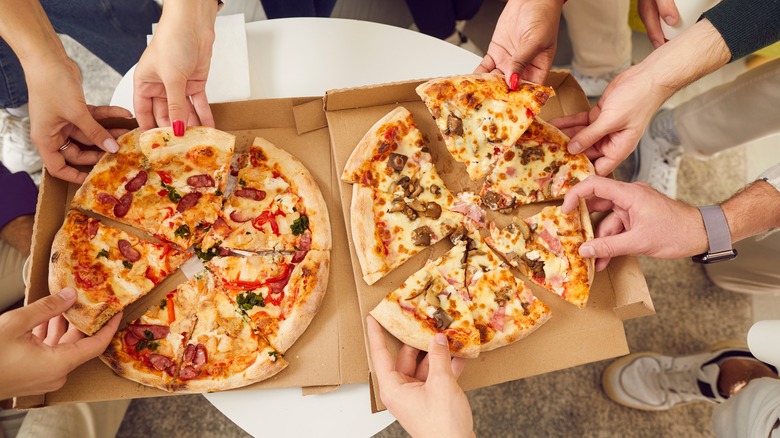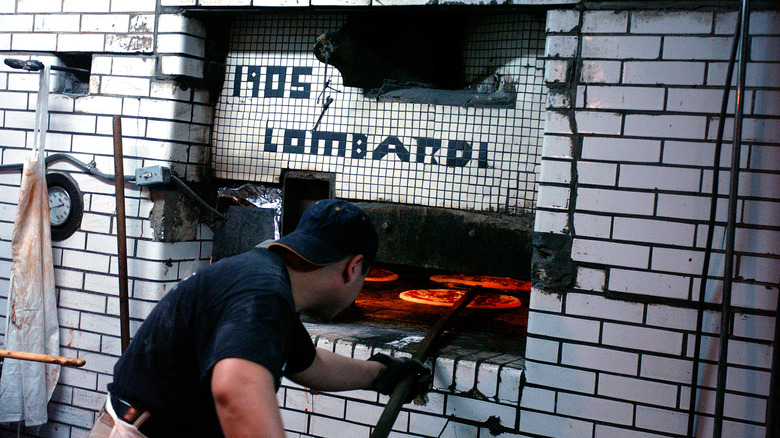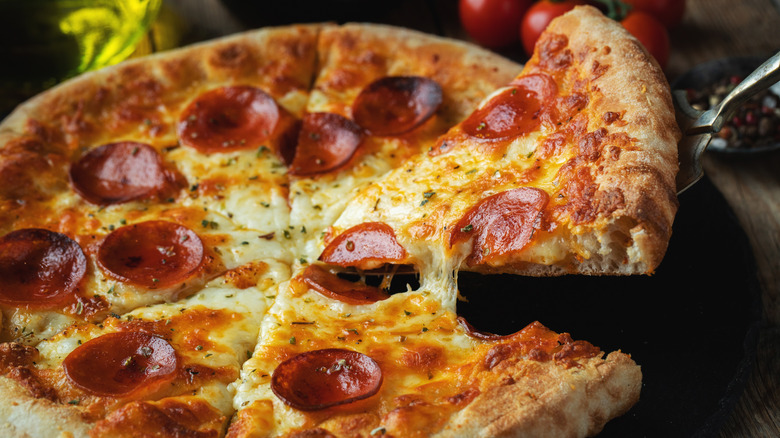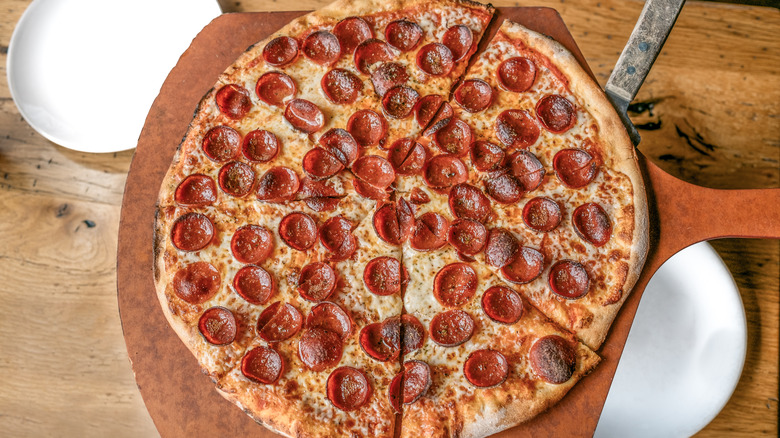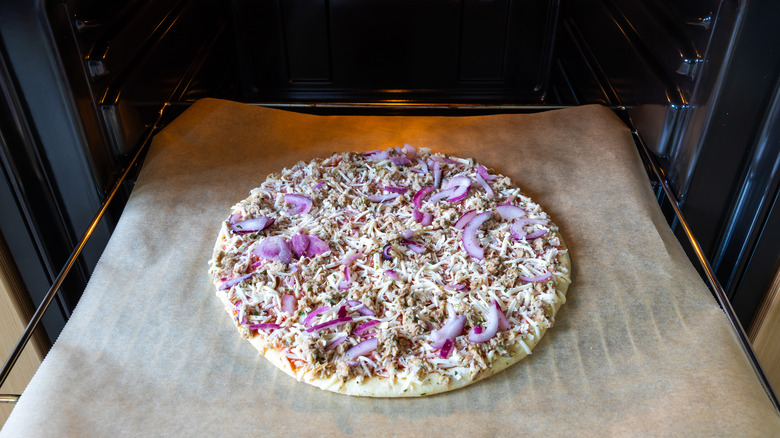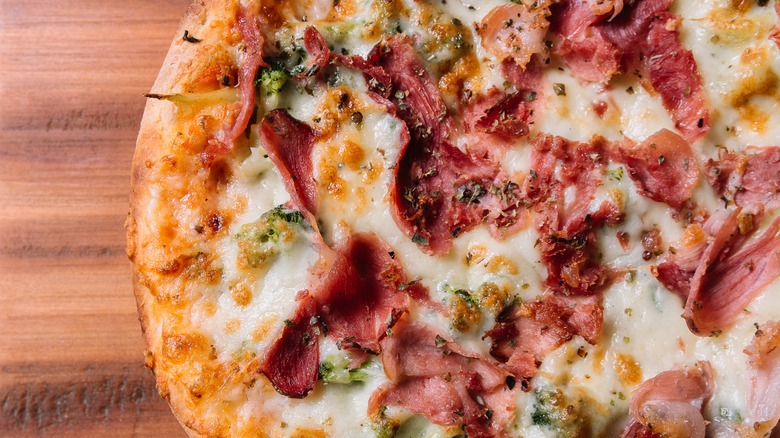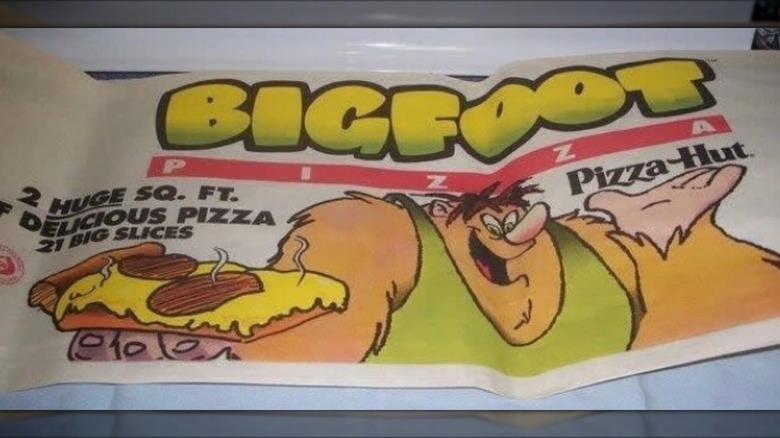How Pizza Became America's Go-To Party Food
A party without pizza isn't a party we want to be invited to. Pizza is a hugely diverse food made in lots of different ways around the world, but no matter where we are, the way that we enjoy it is often the same. It's the kind of thing you eat with friends, talking, laughing, and having a good time. Although pizza by the slice is common in some areas, for the most part it's ordered fresh and sliced into multiple pieces, ideal for enjoying with others. Beyond its sheer proportions, though, pizza has also taken on a cultural significance as a party food, particularly in America, where it's frequently associated with beer, margaritas, and college students.
How did it develop this reputation? In its modern form, pizza began life as a food for working people in 18th-century Naples and later championed by Queen Margherita of Savoy. As such, the way it became a dish that flew around on the back of motorcycles to feed hungry party-goers in the United States feels a little unclear. Well, we decided to figure out exactly how this shift occurred. Take a trip with us back through culinary history, as we uncover the truth on how pizza became America's favorite party food.
Pizza first kicked off in the United States in New York
Pizza is perhaps the most famous cultural import to the United States, and its story in the country began in the late 19th century. During this period, a wave of immigrants from Italy (and specifically Naples) to America brought their culinary traditions with them, and pizza was high on the menu. Originally, Neapolitans immigrated to the country to take on factory work and made pizza for sustenance — but as word spread about its deliciousness, people in the U.S. began to take notice.
As a result, the first pizza shops popped up in New York, Boston, and the surrounding areas. Some of these shops, like Lombardi's, are still in operation today. This part of the country acted as the gateway to the rest of America, and before long pizza was spreading to other areas, with folks realizing both how tasty and how shareable it was. Today, these first pioneers of pizza in the U.S. are celebrated as the vanguard of a cultural force that changed the face of American food forever.
After World War II, pizza's appeal saw a massive spike
Although pizza began gaining popularity in the United States throughout the late 19th and early 20th century, it didn't quite make the big leagues until World War II came and went. During the war, American soldiers were sent over to Italy, with a strong presence in the South of the country due to various invasions and sieges. While over there, these soldiers developed a passion for the local cuisine, and specifically for pizza.
Upon returning to the U.S., the American soldiers were craving the pizza that they ate overseas, creating a window of opportunity for pizzerias in the country to take flight. Additionally, the post-war boom saw people suddenly have more access to disposable income and opportunities to eat out and socialize, which allowed pizza makers in the U.S. to make brisk business. The combo of demand and spending power led to pizza suddenly becoming a must-have food, and as more people became aware of pizza, it only grew from there.
Pizza's dimensions lent it naturally to socializing
Here's the thing about pizza: It's made for sharing. That may not have always been the case, with the first people to eat pizza back in 18th-century Naples grabbing personal pies to eat after work, but it established itself in America as a social food. This communal spirit, which began to show itself vividly in the mid-20th century, is captured in a 1949 article from The Atlantic. "This is a pizza, Italian for pie," the article states. "There is a plural, pizze, but no one ever uses it, for pizza is a sociable dish, always intended to be shared."
This sharing spirit was made even stronger by the fact that pizza by the slice didn't take off until the 1950s. Before this, pizza had to be made in a traditional wood-fired oven, with each pie formed by hand and cooked one at a time. The 1950s, however, saw the invention of the gas-fired oven, and with it an ability to churn out pizzas more quickly and sell them in individual pieces to be eaten on the go. Before this, though, pizza was the kind of thing that was cooked in a regular pizza oven, which you sat down and savored with your besties.
Frozen pizza allowed people to share their pies at home
The 20th century saw a huge amount of advancements in food technology, but perhaps none were as monumental as the advancement of frozen food. Flash-freezing food was first pioneered in 1924, and before long people were plunging anything they could think of to subzero temperatures. One of the first companies to do this with pizza was Totino's, which started life as a pizzeria in 1951 before branching out into frozen pies in 1962. Before long, Totino's had blown up, and by the end of the 1960s it was churning out countless frozen pizzas for folks to enjoy at home.
The success of Totino's and other frozen pizza companies points toward how popular pizza had become in the United States by this point, but also toward new eating habits. People didn't have to go out to enjoy pizza with friends anymore: Now, they could do so in the comfort of their own homes, and bring the party indoors. Pizza companies understood the sociable aspect of this food, with Totino's Party Pizza clearly making a claim to be a good-time food.
The rise of pizza delivery brought the party to your door
The 1960s saw the rise of the frozen pizza, but at the same time, there was another industry beginning to blossom that would take this food to its next phase. The '60s saw the unstoppable rise of fast food, and with it the rise of takeout and delivery pizza. People began to realize that they could enjoy restaurant-quality food at home without having to step foot outside, and pizza lent itself naturally to a fast food format. It could be cooked in mere minutes, traveled well (as long as it was kept flat), and didn't cost a huge amount.
Pretty soon, a major player emerged that would change the face of pizza forever: DomiNick's. Never heard of it? Yes you have — it soon changed its name to Domino's. DomiNick's revolutionized the pizza delivery game, and over time its "30 minutes or less" promise set a new standard for this food. Pizza became more and more convenient, and a natural choice if you were picking something that you wanted quickly to eat with friends.
Pizza's affordability made it appealing to students
Pizza is a very democratic food, and one which is accessible to almost everyone. It's made for sharing, you can put almost anything on it, its toppings are generally well-liked by most people, and gluten-free and vegan options make it edible to almost everybody. Plus, it's famously pretty affordable, and was even more so a few decades back, when it established itself as a student favorite. As pizza continued to grow in popularity in the 1970s, it became a go-to food for hungry college students who were looking for a mid-party (or post-party) bite to eat. Pizzerias became commonplace in college towns and cities across the country, making it even more available to the hungry masses.
The food's popularity among college students and young adults didn't wane after the '70s, but instead continued to grow. A study of pizza consumption undertaken by the Food Surveys Research Group in 2014 found that between 2007 and 2010, 16% of males and 13% of females aged 20-39 ate pizza daily. This consumption rate was the highest among all the adult age groups surveyed.
Pizza's image was revitalized in the 1980s
It's incredible to think there was a time when pizza's popularity was in question, but there was. When the 1980s rolled around, America hadn't exactly fallen out of love with pizza, but things were definitely getting a bit stale. A lot of the innovations that had been made in the last few decades were now starting to feel slightly old-fashioned, and people were getting bored of dense biscuit crusts and limp, stale toppings.
Salvation was needed, and it came in the form of California-style pizza. Beginning in Northern California, it began to spread across the country in 1982 when celebrity chef Wolfgang Puck took the pizza concept to Hollywood, with the later launch of California Pizza Kitchen, one of America's favorite pizza chains, seeing it surge across the country. California-style pizza took standard pies and spun them on their heads, using unconventional toppings that focused on fresh flavors to breathe life into this old classic. Suddenly, pizza was cool again, and everyone wanted to share a slice with their friends — and this experimental sensibility fed into pizza culture in the '90s and beyond.
The Pizza Wars of the 1990s drove prices down and made pizzas even bigger
The 1990s was a decade of extremes, and things were no different when it came to food. Dishes suddenly felt bigger, bolder, and brighter, and businesses were constantly competing with each other to keep their customers. Nowhere was this more obvious than during the Pizza Wars, which kicked off in 1993 and saw Pizza Hut, Domino's, and Little Caesar's go head-to-head with a succession of ads, offers, and promises to customers that created a fever-pitch atmosphere.
Little Caesar's kicked off the war in earnest: Unlike Pizza Hut or Domino's, it didn't offer delivery or dine-in options, but it undercut the competition with a range of new options, including its Big Big Cheese pizza, and low prices. Pizza Hut responded by releasing one of its quintessential 1990s menu items, the Bigfoot Pizza, a 'za measuring in at 2 square feet that would cost customers just $11. Pizza Hut paired the pizza with an enormous marketing campaign to try and dominate the market, and it almost succeeded, until Domino's debuted its Dominator, another supersized pizza. All of this scrapping wasn't just good for customers, who were enjoying huge amounts of food at low prices, but also for pizza's reputation as a party food: Suddenly, there was even more to go around.
The establishment of National Pizza Party Day solidified its status as a party food
It seems like there's a national day for everything, so it's probably no surprise that pizza's got one too. Not just pizza, though: The concept of a pizza party has been enshrined in the calendar. The third Friday of every May is designated as National Pizza Party Day, and the traditional way to celebrate is (what else?) have a pizza party. Grab some friends and head to your favorite pizza restaurant, order in some pizzas from your favorite takeout, or make them at home. As long as you have the food and some pals, you're good to go.
It's probably no great shock that pizza restaurants and supermarkets capitalize on this day to drive business. In 2025, Pizza Hut marked the occasion by rolling out a new deal on its Cheesy Bites Pizza, while in 2024 7-Eleven offered a new frozen pizza to its customers to celebrate the day. We personally didn't need a specific day to hold a pizza party. To us, every day can be a pizza party if you want it to be — but it's nice to have an excuse.
In 2020, pizza became a different type of party food
When the world changed forever in 2020 and lockdowns occurred all over the globe, it felt like parties were out of the question for a long time. However, pizza parties managed to stay alive and kicking. As the world stayed inside, pizza delivery options thrived, and more and more people began ordering it as a way to bring a bit of light into their lives during a trying period. Pizza parties on video platforms like Zoom became common, and in October 2020 a world record was set when more than 3,000 people attended a virtual party hosted by Hormel Foods, who donated $10,000 to Pizza vs. Pandemic to mark the occasion.
Pizza also became a source of comfort throughout this period, and stayed not just a party food, but a salvation. It makes sense, after all: The warming combination of cheese, dough, and sauce is hard to beat in times of crisis, and pizza definitely delivers. When lockdowns were lifted, pizza didn't lose any of its appeal, and as of 2025 it remains as popular as ever.
